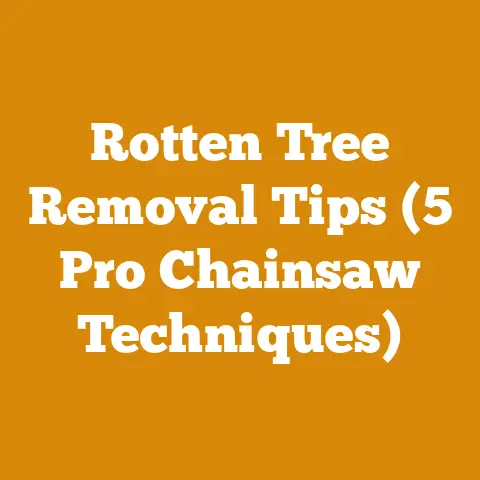Roping Trees Safely to Guide Falls (Expert Arborist Techniques)
Investing in Safety: Expert Arborist Techniques for Roping Trees
As someone who’s spent a considerable chunk of my life among towering trees, I can tell you that felling them safely is an art and a science. It’s not just about pointing a chainsaw and hoping for the best. It’s about understanding physics, respecting nature, and mastering techniques that can save lives. One of the most crucial of these techniques is safely roping trees to guide their fall. This guide is your investment in learning how to do it right, avoiding costly mistakes, and returning home safe every day.
Understanding the Intent: Why Roping Trees Matters
The user intent behind wanting to learn about roping trees safely is multifaceted. Primarily, it’s about controlling the direction of a tree’s fall. This is vital for several reasons:
- Safety: Preventing damage to property, power lines, or, most importantly, people.
- Efficiency: Ensuring the tree falls in a location that makes processing easier.
- Preservation: Protecting surrounding trees and the environment.
This guide will provide the detailed, actionable information needed to safely execute tree felling using ropes, focusing on expert arborist techniques.
The Foundation: Risk Assessment and Planning
Before even thinking about ropes and rigging, a thorough risk assessment is paramount. I’ve seen too many accidents caused by inadequate planning. Remember, a little preparation prevents a lot of problems.
Evaluating the Tree
- Species: Hardwoods like oak and maple have different densities and breaking strengths than softwoods like pine and fir. This affects the forces involved in roping.
- Data Point: Oak has a modulus of rupture (MOR) around 10,000-15,000 psi, while pine is closer to 6,000-8,000 psi. This means oak is significantly stronger and will require different rigging considerations.
- Lean: The natural direction the tree wants to fall. This dictates the complexity of the roping system.
- Defects: Rot, cracks, or other weaknesses that could compromise the tree’s structural integrity. These defects can change the balance and require extra precautions.
- Size: Diameter at breast height (DBH) and height determine the tree’s weight and the forces that will be exerted on the ropes and rigging.
- Data Point: A tree with a DBH of 24 inches and a height of 80 feet can weigh several tons. Accurately estimating weight is crucial for selecting appropriate equipment.
- Crown: The shape and density of the crown influence the tree’s aerodynamics during the fall. A dense crown can catch the wind and alter the trajectory.
Assessing the Surroundings
- Targets: Buildings, power lines, roads, and other trees that need to be protected.
- Escape Routes: Clear paths for the feller to retreat to safety once the tree starts to fall. I always have at least two escape routes planned.
- Soil Conditions: Soft or unstable soil can affect the stability of the rigging and the tree itself.
- Weather: Wind speed and direction can significantly impact the tree’s fall. I never rope trees in high winds.
- Safety Code: Most forestry regulations recommend against felling trees in winds exceeding 20 mph.
Developing a Felling Plan
Based on the tree and surroundings assessment, create a detailed plan that includes:
- Target Felling Zone: The precise location where the tree should land.
- Rope Placement: The optimal height and angle for attaching the rope to maximize control.
- Rigging System: The type of rigging (e.g., simple pull, redirect, mechanical advantage) and the specific equipment needed.
- Communication: Clear signals between the feller and any ground crew.
- Emergency Procedures: A plan for dealing with unexpected events, such as a rope breaking or the tree falling in the wrong direction.
The Arsenal: Essential Equipment and Their Specifications
Using the right tools is non-negotiable. Skimping on equipment can lead to disastrous consequences. Here’s a rundown of the essential gear:
Ropes
- Type: Kernmantle ropes are the standard for tree work. They consist of a core (kern) that provides strength and a sheath (mantle) that protects the core from abrasion.
- Material Specification: Look for ropes made from high-tenacity nylon or polyester. These materials offer excellent strength, abrasion resistance, and UV resistance.
- Diameter: Typically ranges from 1/2 inch to 3/4 inch, depending on the size of the tree and the rigging system.
- Data Point: A 1/2-inch rope typically has a minimum breaking strength (MBS) of around 8,000 lbs, while a 3/4-inch rope can have an MBS of over 13,000 lbs.
- Length: Sufficient length to reach the desired attachment point on the tree and provide enough slack for the rigging system. I prefer having extra length rather than not enough.
- Working Load Limit (WLL): The maximum weight a rope can safely handle. This is typically a fraction of the MBS (e.g., 1/5 or 1/10).
- Safety Code: Always stay well below the WLL of the rope. Overloading can cause catastrophic failure.
- Inspection: Regularly inspect ropes for cuts, abrasions, chemical damage, and other signs of wear. Retire any rope that shows signs of damage.
- Practical Tip: Keep a log of rope usage and inspection dates. This helps track the rope’s history and identify potential problems.
Rigging Hardware
- Carabiners: Used to connect ropes to other rigging components.
- Material Specification: Must be made from high-strength steel or aluminum alloy and have a locking mechanism.
- Data Point: Carabiners are rated by their major axis strength (the force they can withstand when loaded along their longest dimension). Look for carabiners with an MBS of at least 5,000 lbs.
- Pulleys: Used to redirect ropes and create mechanical advantage.
- Material Specification: Must be designed for tree work and have a high WLL.
- Data Point: Pulleys come in various sizes and configurations. Choose a pulley with a sheave (the grooved wheel) that is compatible with the rope diameter being used.
- Slings: Used to create attachment points around the tree.
- Material Specification: Made from high-strength webbing or rope.
- Data Point: Slings are rated by their vertical, choker, and basket hitch capacities. Choose a sling with a WLL that is appropriate for the load being applied.
- Tree Straps/False Crotches: Protect the tree from rope abrasion and create a smooth running point.
- Material Specification: Heavy-duty webbing with reinforced loops.
- Practical Tip: Use tree straps with a wide surface area to distribute the load and minimize damage to the tree bark.
- Winches/Come-Alongs: Used to apply tension to the rope and pull the tree in the desired direction.
- Data Point: Winches are rated by their pulling capacity. Choose a winch with a capacity that is significantly greater than the estimated weight of the tree.
- Safety Code: Always use a winch with a built-in overload protection system.
Chainsaws
- Size: The size of the chainsaw should be appropriate for the size of the tree being felled.
- Data Point: For trees with a DBH of less than 12 inches, a chainsaw with a 16-inch bar is usually sufficient. For larger trees, a chainsaw with a 20-inch or longer bar may be necessary.
- Maintenance: Keep the chainsaw properly maintained, including sharpening the chain, cleaning the air filter, and checking the fuel and oil levels.
- Tool Requirement: Use a chainsaw chain sharpener to maintain the correct cutting angle and depth.
- Safety Features: Ensure the chainsaw has functional safety features, such as a chain brake, a throttle interlock, and a chain catcher.
- Safety Code: Always wear appropriate personal protective equipment (PPE) when operating a chainsaw, including a helmet, eye protection, hearing protection, gloves, and chaps.
Personal Protective Equipment (PPE)
- Helmet: Protects the head from falling debris.
- Eye Protection: Protects the eyes from sawdust and flying chips.
- Hearing Protection: Protects the ears from the loud noise of the chainsaw.
- Gloves: Protect the hands from cuts and abrasions.
- Chaps: Protect the legs from chainsaw cuts.
- Steel-Toed Boots: Protect the feet from falling objects.
- High-Visibility Clothing: Makes the wearer more visible to others.
The Art of Rigging: Techniques for Controlled Felling
Now, let’s delve into the core of this guide: the techniques for safely roping trees.
Simple Pull
This is the most basic rigging system, suitable for trees with a slight lean in the wrong direction.
- Attach the Rope: Tie the rope as high as possible on the tree, using a secure knot like a bowline or a running bowline.
- Practical Tip: Use a throw line to get the rope over a high branch.
- Anchor the Rope: Secure the other end of the rope to a sturdy anchor point, such as another tree or a winch.
- Apply Tension: Gradually apply tension to the rope while making the felling cuts.
- Control the Fall: Use the rope to pull the tree in the desired direction as it falls.
Redirect
This technique is used when the anchor point is not directly opposite the desired felling direction.
- Attach the Rope: Tie the rope to the tree as in the simple pull method.
- Set Up a Redirect: Use a pulley or a sling to redirect the rope’s path. The redirect point should be located between the tree and the anchor point, at an angle that allows you to pull the tree in the desired direction.
- Practical Tip: Choose a redirect point that is strong and stable. Avoid using small branches or weak structures.
- Anchor the Rope: Secure the rope to the anchor point.
- Apply Tension: Apply tension to the rope while making the felling cuts, using the redirect to guide the tree’s fall.
Mechanical Advantage
When dealing with larger trees or situations where more pulling power is needed, a mechanical advantage system can be employed. This involves using multiple pulleys to multiply the force applied to the rope.
- Choose a System: Common mechanical advantage systems include the Z-rig, the 3:1, and the 5:1. The higher the ratio, the more pulling power is gained, but the slower the rope movement.
- Data Point: A 3:1 system means that for every 3 feet of rope pulled, the load moves 1 foot.
- Set Up the System: Attach pulleys to the tree, the anchor point, and the rope itself, according to the chosen system.
- Apply Tension: Pull on the rope to create tension in the system. The mechanical advantage will multiply the pulling force, making it easier to control the tree’s fall.
- Practical Tip: Use high-quality pulleys with smooth-running sheaves to minimize friction and maximize efficiency.
Advanced Techniques: The Speedline
The speedline technique is more advanced and is typically used to move sections of a tree away from the felling site, especially in urban environments. This involves rigging a rope between the tree and a remote anchor point and using it to slide cut sections of the tree along the rope.
- Set Up the Speedline: Securely attach a rope between the tree and a distant anchor point, ensuring the rope is taut and can handle the weight of the tree sections.
- Attach Rigging: Use specialized rigging hardware to attach the cut sections to the speedline.
- Controlled Descent: Carefully lower or slide the sections along the speedline to the designated drop zone.
- Safety Code: This technique requires advanced training and experience. Never attempt it without proper instruction.
Precision Cutting: The Felling Cuts
The felling cuts are just as important as the rigging. A poorly executed cut can cause the tree to fall in an unexpected direction, even with a rope attached.
The Notch
The notch determines the direction of the fall. It should be cut on the side of the tree facing the desired felling direction.
- Angle: The notch should be cut at a 45-degree angle, with the bottom cut being slightly deeper than the top cut.
- Depth: The notch should be about 1/3 of the tree’s diameter.
- Practical Tip: Use a chainsaw with a sharp chain and a consistent cutting angle to create a clean, precise notch.
The Hinge
The hinge controls the speed and direction of the fall. It’s the uncut wood between the notch and the back cut.
- Thickness: The hinge should be about 1/10 of the tree’s diameter.
- Data Point: A tree with a 20-inch diameter should have a hinge that is about 2 inches thick.
- Placement: The hinge should be directly behind the notch, and it should be of uniform thickness.
- Practical Tip: Avoid cutting through the hinge, as this can cause the tree to fall uncontrollably.
The Back Cut
The back cut is the final cut that releases the tree.
- Height: The back cut should be slightly above the bottom of the notch.
- Technique: Make the back cut slowly and carefully, paying attention to the tree’s movement.
- Wedges: Use wedges to prevent the tree from pinching the chainsaw bar and to help push the tree over.
- Tool Requirement: Carry a variety of wedges, including plastic and metal wedges, to suit different tree sizes and situations.
Understanding Wood: Species, Moisture, and Strength
Knowing the properties of different wood species is crucial for safe and efficient tree felling and processing.
Hardwoods vs. Softwoods
- Hardwoods: Generally denser and stronger than softwoods. Examples include oak, maple, and ash.
- Data Point: Hardwoods typically have a higher density and a slower drying rate than softwoods.
- Softwoods: Generally less dense and weaker than hardwoods. Examples include pine, fir, and spruce.
- Data Point: Softwoods are often easier to split and dry than hardwoods, making them a popular choice for firewood.
Moisture Content
The moisture content of wood affects its weight, strength, and burning properties.
- Green Wood: Freshly cut wood with a high moisture content (typically 50% or more).
- Technical Limitation: Green wood is heavy, difficult to split, and burns poorly.
- Seasoned Wood: Wood that has been allowed to dry to a lower moisture content (typically 20% or less).
- Data Point: Seasoned wood is lighter, easier to split, and burns more efficiently.
- Kiln-Dried Wood: Wood that has been dried in a kiln to a very low moisture content (typically 6-8%).
- Technical Limitation: Kiln-dried wood is expensive but offers consistent burning performance.
- Drying Times: Drying times vary depending on the wood species, the climate, and the storage conditions.
- Practical Tip: Stack firewood in a single row, with good air circulation, to promote faster drying.
Wood Strength
The strength of wood is determined by its species, density, and moisture content.
- Tensile Strength: The ability of wood to resist being pulled apart.
- Compressive Strength: The ability of wood to resist being crushed.
- Bending Strength: The ability of wood to resist bending under load.
- Data Point: Oak has a higher bending strength than pine, making it a better choice for structural applications.
Case Studies: Real-World Applications
To illustrate the principles discussed above, let’s look at a couple of case studies:
Case Study 1: Felling a Leaning Oak Near a House
- Challenge: A large oak tree was leaning dangerously towards a house. The tree was also close to a power line.
- Solution: A team of arborists used a combination of roping and precision cutting to safely fell the tree away from the house and the power line.
- Risk Assessment: The team identified the house, the power line, and the tree’s lean as the primary hazards.
- Rope Placement: A rope was attached high on the tree, opposite the direction of the lean.
- Rigging System: A redirect system was used to guide the tree’s fall around the power line.
- Felling Cuts: A precise notch and back cut were made, and wedges were used to help push the tree over.
- Controlled Fall: The rope was used to pull the tree in the desired direction as it fell.
- Outcome: The tree was safely felled without damaging the house or the power line.
Case Study 2: Removing Sections of a Dead Ash Tree in a Park
- Challenge: A large ash tree had died and was posing a hazard to park visitors. The tree was located in a densely populated area, making it difficult to fell the entire tree at once.
- Solution: The team used the speedline technique to remove sections of the tree safely.
- Speedline Setup: A rope was rigged between the tree and a remote anchor point.
- Section Removal: The team carefully cut sections of the tree and attached them to the speedline.
- Controlled Descent: The sections were then lowered or slid along the speedline to a designated drop zone.
- Outcome: The tree was safely removed without disrupting park activities or endangering park visitors.
Safety First: Best Practices and Common Mistakes
Safety should always be the top priority. Here are some best practices and common mistakes to avoid:
Remember, every tree is different, and every situation presents unique challenges. By combining the knowledge gained from this guide with practical experience and a dedication to safety, you can confidently and safely fell trees using ropes, protecting yourself, others, and the environment. And always remember, safety is not just a rule; it’s a way of life in the woods.






